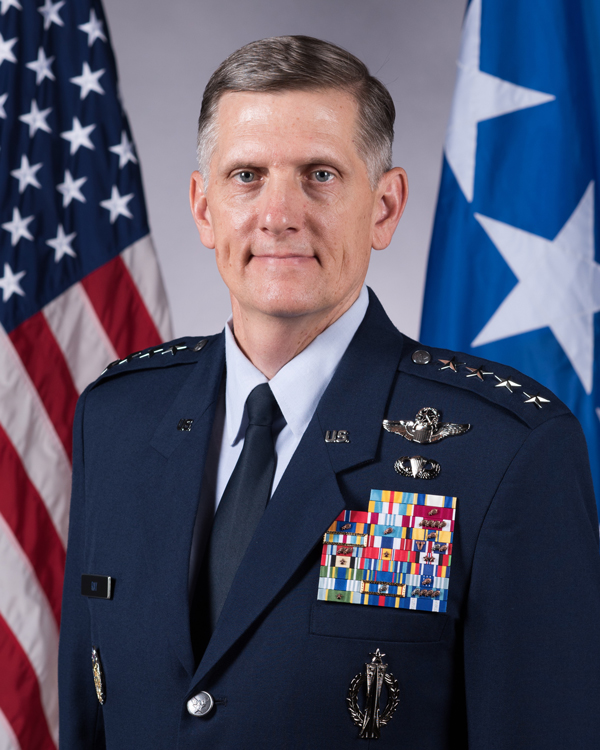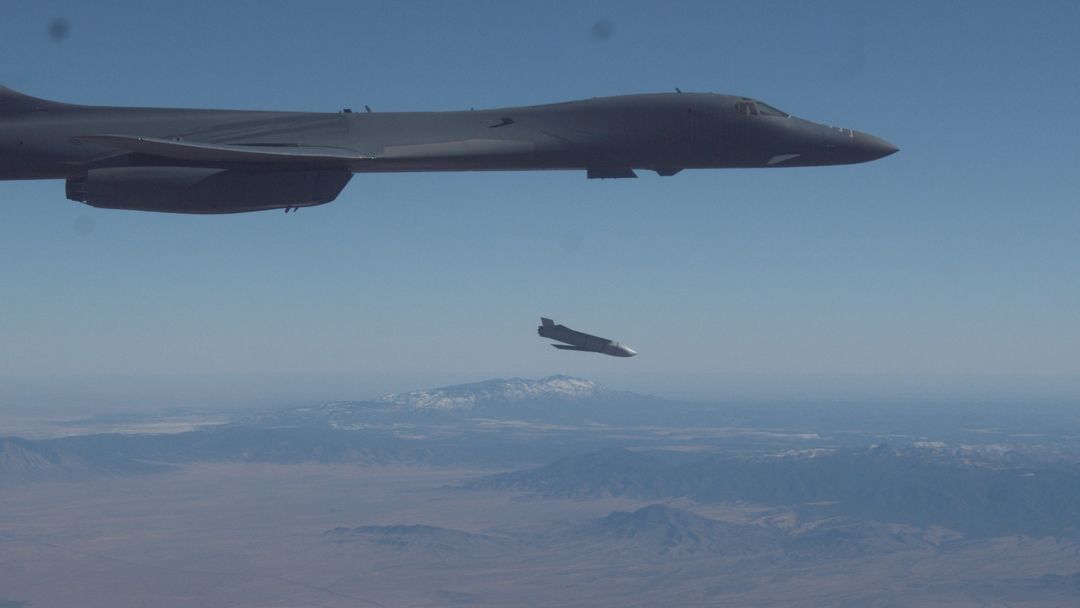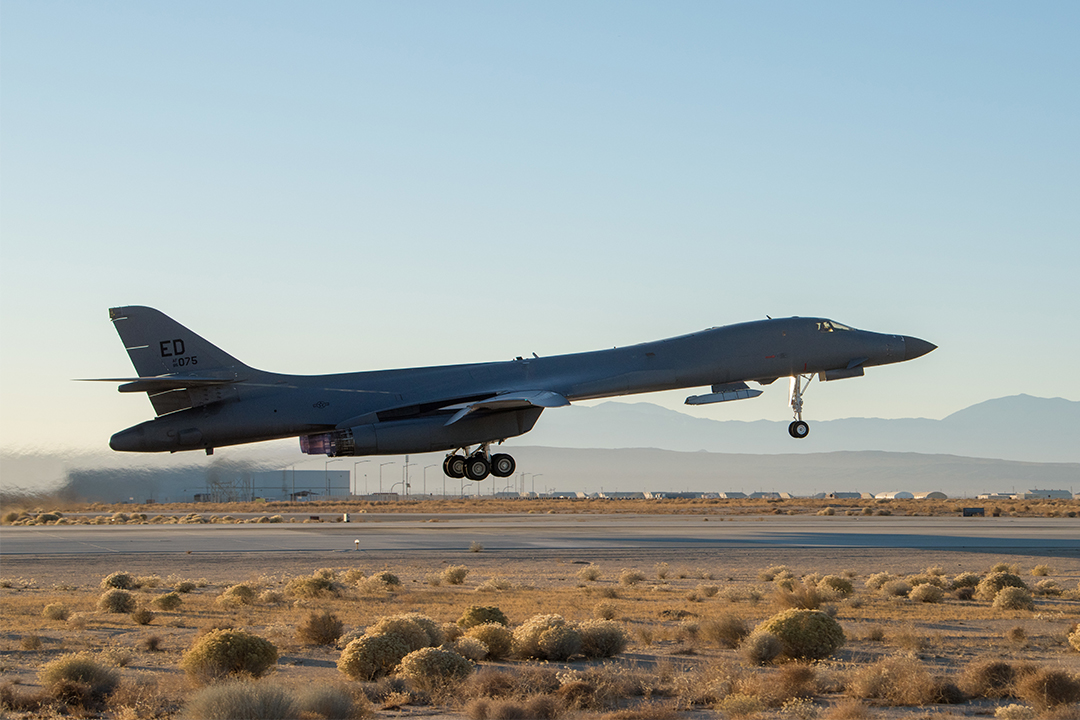
Published in the February/March 2021 Issue – General Timothy Ray, commander, Air Force Global Strike Command and his staff provide Armada International an exclusive insight into the command’s responsibilities to provide America with a capable strategic bomber force.
As the boss of Air Force Global Strike Command (AFGSC) and the air component commander of US Strategic Command (STRATCOM), General Timothy Ray has 156 bombers and 400 intercontinental ballistic missile (ICBMs) under his control and is tasked with the US Air Force’s (USAF) core global strike mission.
“We [AFGSC) are responsible for a strategically significant fleet of systems capable of delivering the nation’s weapons,” began General Ray. “Our western alliance has no bombers, or open bomber production lines. Nor does our alliance have any ICBMs or ICBM production lines. The Air Force’s 156 bombers and 400 ICBMs, in addition to the US Navy’s 240 submarine-launched ballistic missiles, are all our nation has to compete, deter and win when it comes to strategic victory.”

Maintaining Bomber Presence
On 17 April 2020, the USAF announced the end of its 16-year Continuous Bomber Presence (CBP) at Andersen Air Force Base, Guam, at the heart of US Indo-Pacific Command’s area of responsibility. According to AFGSC, the CBP was the means to project assurance towards America’s allies and to provide deterrence, a primary AFGSC mission. The command said the right sizing of a forward projected bomber footprint is [now] the goal, adding: “The world is very dynamic and the combatant commanders’ appetite for a bomber presence to assure and deter has not lessened. Presenting bomber forces deliberately and predictably will meet mission requirements and enable commanders at all levels to be more effective with available resources.”
During the 16-year period, bombers operating from Andersen or other bases around the world were present at Bomber Assurance and Deterrence (BAD) deployments designed to assure allies and deter adversaries in a region. The term Bomber Assurance and Deterrence, however, is no longer the preferred term and Bomber Task Force (BTF) is now the term-of-use. AFGSC said: “Although the title has changed, as long as nuclear weapons exist, there will be no mission more important than maintaining the nation’s nuclear capability and ensuring strategic deterrence and assurance.

“Twenty-first century strategic deterrence is vitally important to the defence of our nation and its allies. Deterrence occurs when a military capability and will is judged by adversaries as sufficiently strong to discourage any would-be aggressor from starting a war because of the fear of retaliation. The nuclear triad has a stabilising influence on our allies, partners and adversaries. Assurance allows our nation, allies and partners to know that we will compete, deter and win when it comes to strategic victory.”
BTF refers to a deployment or employment of bomber forces executed in support of theatre combatant commander’s objectives. Bomber forces regularly conduct combined theatre security cooperation engagements with allies and partners, demonstrating America’s capability to command, control and conduct bomber missions across the globe. AFGSC said: “Bomber missions also demonstrate the credibility and flexibility of our forces to address today’s complex, dynamic and volatile global security environment. BTFs are defined to be persistent because they are able to operate in real-time across an ever-changing global environment. One prime example is how BTF operations have continued, uninterrupted, despite the current pandemic.”
Strategically, an ongoing continuous bomber presence in the Indo-Pacific region differs to a short-term BTF, so why did the USAF make the change? According to AFGSC, the US Department of Defense (DoD) has transitioned to a Dynamic Force Employment (DFE) concept of operation in line with the National Defense Strategy. The DFE concept enables American strategic bombers to operate from a broader array of locations in the Indo-Pacific region and/or from the continental United States, and to do so when required, and with greater operational resilience. AFGSC commented: “In the transition from CBP to BTF operations under the DFE concept, we had to give priority to maintaining the capacity and capabilities for major combat, while providing bomber force deployment options for proactive and scalable employment of the joint force. A modernised global operating model of combat-credible, flexible theatre postures will enhance our ability to compete and provide freedom of manoeuvre during conflict, providing national decision-makers with better military options.”
Whatever titles are used, whichever concept of operations is currently defined, men and women assigned to AFGSC bomber squadrons continue to fly operational missions around the globe. Today’s bomber aircrews do so under the operational concept dubbed Agile Combat Employment (ACE). This leverages networks of well-established and austere air bases, multi-capable airmen, pre-positioned equipment, and airlift to rapidly deploy, disperse and manoeuvre combat capability throughout a theatre. Paired with aircraft fuelling, arming and limited maintenance activities, ACE expands the number of bases from which the Air Force can generate combat sorties.
The Air Force unveiled its shift to the ACE concept in 2017. According to AFGSC, by using cross-major command initiatives and coordination, ACE has evolved to produce multidisciplinary support personnel for recurrent use in exercises, the results from which have served as the foundation to further interoperability. AFGSC added: “US strategic bombers will continue to operate in the Indo-Pacific, to include Guam, at the timing and tempo of AFGSC’s choosing. We continue to maximise all opportunities to train alongside allies and partners to build interoperability and bolster the collective ability to be operationally unpredictable. AFGSC continually reassesses its overseas posture and adjusts its footprint to meet the requirements of the joint force and combatant commanders as well as its treaty commitments.”

Capability Transition
In his statement to the Senate Armed Service Committee on Strategic Forces in May 2019, General Ray said AFGSC must bring about a significant transition in its capabilities and its thinking as it turns its attention to potential conflict with global competitors with more capable technology and growing strategic capabilities.
To bring about such a transition, AFGSC is harnessing strategic capabilities with the development of the Boeing B-1B Lancer into a platform that can carry hypersonic weapons. Furthermore, the B-1B platform is being upgraded from legacy communication systems to ones that enable in-air secure communications from anywhere in the world. General Ray said that the manner in which AFGSC trains, prepares, sustains, and modernises must also change.
AFGSC needs to effectively utilise the full range of training methods. From legacy lecture and hands-on tuition through advanced methods and tools of instruction such as student-centred learning, artificial intelligence (AI) and virtual reality.
It is common for the Air Force to cite bilateral training as a benefit created from a BTF mission. Imagery released of some BTF missions generally shows allied aircraft, usually fighters, flying in formation with B-1, B-2 or B-52 bombers. This implies that bilateral training is limited to intercept and escort roles, but AFGSC cites other benefits provided by bomber missions including;
- Opportunities to train with allies and partners in joint and coalition operations and exercises.
- Aircrew familiarisation with air bases and conducting flight operations in different geographic combatant commands.
- An enabler for aircrews to maintain a high state of readiness (see below) and proficiency, and validation the command’s always-ready, global strike capability.
- A routine, visible demonstration of America’s commitment to its allies and partners by the global employment of its bomber force.
The main requirement for maintaining a high state of readiness in the bomber force resides within its training programmes which should replicate the difficulties of combat. AFGSC uses a building block approach that rests on improvement through mission debrief and feedback and the emphasise the critical role each individual plays in support of their team.
To increase aircraft availability and to sustain legacy fleets will require the use, and leveraging, of predictable analysis, agile manufacturing technologies, local fabrication and repair, and censor based line replaceable units.
In terms of modernisation, AFGSC is looking towards the future of aircraft maintenance by using procedures such as Cold Spray technologies to accomplish component repairs. Ellsworth Air Force Base, South Dakota, home to the B-1B-equipped 28th Bomb Wing, is the Air Force’s key Cold Spray node.
Members assigned to the 28th Maintenance Squadron’s Additive Manufacturing and Rapid Repair Facility conducted the first repair using cold spray technology. On 8 April 2020, the squadron repaired a forward equipment bay panel using the cold spray technology, and did so using Air Force guidance and technical orders, with Air Force owned equipment. Cold Spray uses a machine that shoots metals at supersonic speeds onto an aircraft component. The metals mix and bond together, filling any missing or damaged areas to restore the part. Additionally, AFGSC has invested in additive manufacturing with the capability to use 3-D printing to produce polymer components and prototyping.
According to General Ray, as modernisation and sustainment programmes progress, ongoing analysis will also be conducted to enable risk-informed and balanced decisions to be made throughout all phases of the acquisition process.
As Air Component Commander, General Ray is able to monitor, control, and direct all of the air assets assigned or attached to USSTRATCOM anywhere in the world. Back in May 2019, Ray said the command’s re-organisation had revealed long-term invalid concepts and systems. He noted how the discoveries had provided an opportunity to implement new alternatives. Examples given were the prioritisation of weapon system sustainment and modernisation.
Citing the Acquisition Statement published by General Charles Brown, chief of staff of the Air Force in his strategy document titled Accelerate Change or Lose, AFGSC said: “We are in lockstep with the objectives and must learn to be agile, adapt to the future and continue to work with its joint partners to design and field the future force required. The command is identifying systems and programmes that are outdated and/or unaffordable, to make way for capabilities that will make AFGSC competitive in a future high-end fight. Furthermore, AFGSC recognises it is operating in an era of great-power competition, and must accelerate its understanding and mastery of the competition. This must be undertaken simply to accrue war-fighting advantages to the United States and its allies and partners; enhance collective deterrence credibility; and drive the competitions to areas of US advantages and/or competitors’ weaknesses.”
The term great-power competition first appeared in the 2017 National Security Strategy and has become a watchword within the US DoD since.
Bomber Fleet
General Ray’s assigned fleet of 156 bombers comprises B-1B Lancer, B-2 Spirit and B-52H Stratofortress aircraft. One fascinating fact is the age of the aircraft, the youngest in the entire 156-aircraft fleet is just over 23 years old. That aircraft is B-2, serial number 93-1088, which was delivered to Whiteman Air Force Base, Missouri in November 1997. That’s much younger than B-1B Lancer, serial number 86-0140, which was delivered to the Air Force in April 1988 making the jet a mere 32 years and 9 months old. However, no surprise that the ‘granddaddy of the fleet’ goes to a B-52H. Aircraft serial number 61-0040 was delivered to the then Strategic Air Command in October 1962 making it a 58-year old jet. Other active B-52s are already 60!

B-1B Lancer
The airmen who operate and maintain B-1B aircraft are, according to AFGSC, providing a crucial bridge to the force build-up to more than 225 bombers. This refers to maintaining an adequate B-1B force capability through a heavy B-52 test period and the initial build-up of the nascent B-21 Raider. During this time frame, the B-1B fleet will give the Air Force the margin needed to transition the bomber force to meet National Defense requirements. The term heavy B-52 test period refers to a period during which various flight test efforts for various programmes destined for Boeing’s eight-engine monster.
AFGSC stated that the B-1B’s retirement timeframe is a key component to effective fleet management during the transition to the B-21 Raider. According to AFGSC, the Air Force continues to invest in maintaining B-1B combat effectiveness and will do so until key modernisation milestones are achieved: “The B-1B recently completed the most significant modernisation programme in its 35-year history. This included the integrated battle station and cockpit upgrades to provide the crew with a more user-friendly integrated cockpit. In addition, the Air Force is currently considering re-activating the aircraft’s external carriage capability, increasing its payload capacity to between 30 and 36 AGM-158-series air-to-surface missiles, and nascent hypersonic weapons. The B-1B is currently the threshold platform for the Hypersonic Attack Cruise Missile and the objective platform for the AGM-183 Air-launched Rapid Response Weapon.”
Despite its crucial bridge categorisation, the Air Force will retire 17 of the most-costly and structurally deficient B-1Bs in the fleet from 2021, but how does AFGSC propose to manage the remaining aircraft given that the Lancer fleet held continuous deployments for 15 years and the highest time airframe has accumulated over 12,000 flight hours?
According to AFGSC: “The limited aircraft retirement will contribute to funding investments in key capabilities for the future joint force. It will also allow B-1B maintainers to focus their efforts on the healthiest B-1Bs that remain in the fleet, thus providing a much needed positive impact on one of our most high-stressed teams. The planned decrease of B-1B aircraft from FY2021 supports the shaping of the B-1B fleet so that it remains an effective long-range precision strike force that will provide margin during the bomber transition and incur less cost to reach the future bomber force faster.”
Given the service life of the B-1B fleet has been extended several times, aircraft have been flown beyond their original and extended service lives, airframes have developed numerous structural issues, and the fact that the aircraft was not designed for decades of conventional combat, the question arises about what processes the AFGSC has in place to mitigate the issues resident in these old, well-used aircraft. Responding, AFGSC said: “We continue to invest in maintaining B-1B combat effectiveness until key modernisation milestones are achieved. Make no mistake, the B-1B fleet we have, is combat ready and can employ weapons anywhere in the world in support of the United States, and its Allies and partners.”

B-52H Stratofortress
For over 40 years, the B-52’s structural health has been monitored as part of the Air Force’s Aircraft Structural Integrity Program. By recording flight time, flight activity and operational loads data among many other factors, and inputting the data into a computer model provides the expected service life of the aircraft. These efforts have enabled the Air Force to derive the B-52 will be able to remain in service until at least 2050.
To keep the B-52H in the fight through 2050, the Air Force is investing in a number of improvements to ensure continued readiness in today’s combat environment. These include the 1760 Internal Weapons Bay Upgrade which will increase smart weapon capacity by 67 percent, equivalent to adding 22 B-52s to the fleet, as well as the B-52H Radar Modernisation Program (RMP). This is a high-priority item with an expected initial operational capability (IOC) to be declared on 11 B-52s in 2026. RMP prime contractor Boeing has selected Raytheon to produce a new active electronically scanned array (AESA) radar. A model that will be based on, and use, technologies developed for the company’s APG-79 and APG-82 units.
Equally significant is the B-52H Commercial Engine Replacement Program. Once implemented, new engines are estimated to offer large maintenance cost savings. According to AFGSC’s prediction, the new engines will prove so reliable that they will not have to be removed from the aircraft for up to 20 years.
B-2 Spirit
After years of delays and technical issues, the B-2’s Defensive Management System Modernisation (DMS-M) programme experienced a funding reduction and the programme was terminated in the FY2021 budget estimate submission. The programme’s remaining funds enabled a restructure of DMS-M into the B-2 Displays Modernisation (BDM) programme, which provides the B-2 with a replacement for ageing and unsupportable crew station displays. According to facts listed in the Air Force FY2021 budget request, the restructure is set to be implemented over the next five years. The BDM should begin fielding in FY2025.
Prior to its termination, General Ray had called the DMS-M a must-pay bill for continued lethality, so does omission of DMS-M, comprising new antennas and avionics that help detect and identify threats and ground-based air defence systems, detract from the B-2’s future survivability? AFGSC says no, “omission of DMS-M does not detract from the B-2’s future survivability, because the Air Force funded other survivability efforts that provide capability to the aircraft against emerging threats.”
by Mark Ayton
Editor’s note: When AFGSC is quoted, the reply was submitted by General Ray’s staff specifically for this article.













